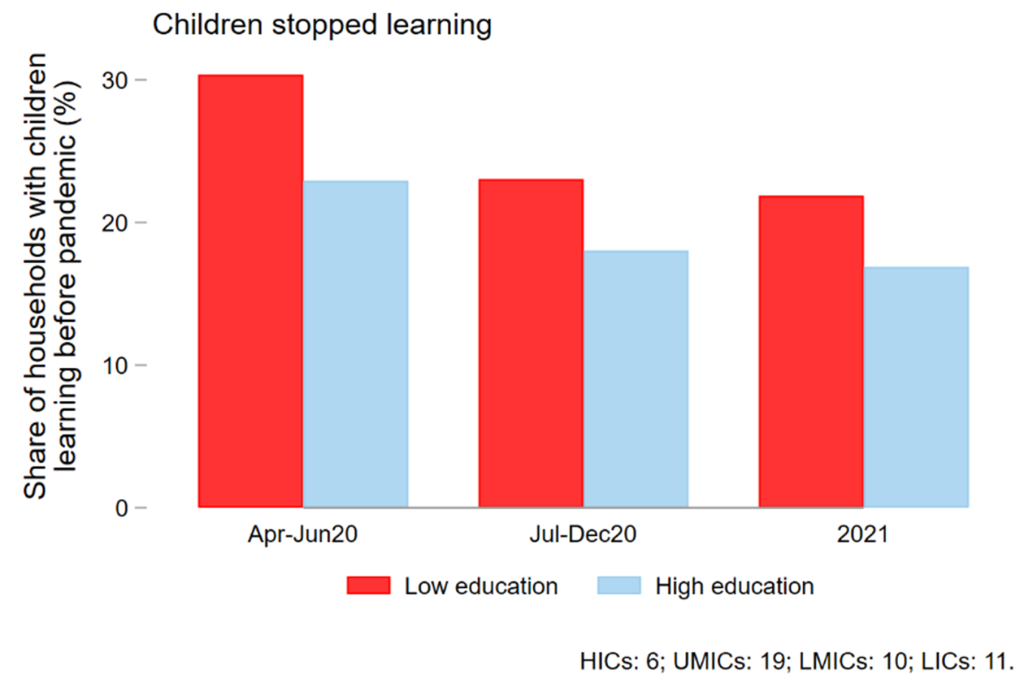 Photo of masked women selling food at the side of the road: World Bank/Sambrian Mbaabu
Photo of masked women selling food at the side of the road: World Bank/Sambrian Mbaabu
Three years into the COVID-19 pandemic, the world is still recovering from disruptions in lives and welfare that were unprecedented in recent times. In 2020, global poverty increased for the first time since 1998 and likely has not returned to pre-pandemic levels yet. Global supply-chain disruptions and containment measures including lockdowns, quarantines, and social distancing resulted in steep job losses, and recovery has been hindered by the energy and food price crises, climate shocks, and the war in Ukraine. But how has the welfare of households evolved after the initial COVID-19 shock?
A recent paper sheds light on the topic. The analysis was based on more than 300 high-frequency phone surveys (HFPS) in 80 countries during 2020 and 2021 — representing a universe of over 2.5 billion people. It focused on the scarring effects of the initial losses of employment and income by documenting patterns of recovery within and across countries, as restrictions on mobility were gradually relaxed.
The main conclusion of the paper is that, unless proper remediation takes place in a timely way, the uneven impacts associated with COVID-19 on welfare may be amplified over the medium to long term, leading to future increases in global poverty and inequality. The statement is supported by four findings:
First, female, informal, and less-educated workers stopped working to a greater degree initially and they have recovered employment at a slower pace.
Women were less likely to gain or recover employment during 2020 and 2021, especially when there were young children in the household. This is in part because stay-at-home measures had a stronger effect on employment for women relative to men. We estimate that less educated women with children were between 14 and 17 percentage points more likely to have stopped working and 19 percentage points less likely to have returned to work compared to more educated men with children.
The employment gap along the dimensions of gender and education grew wider as the pandemic evolved, accentuated by the burden of childcare on women. This is especially worrisome because in countries with higher pre-pandemic income inequality, women and lower-educated workers were more likely to lose jobs than their counterparts (Figure 1), which points to a vicious circle from higher inequality to more unequal impacts to, potentially, more inequality in the future.
Figure 1. Gender gap in work stoppages in 2021 vs. prepandemic income inequality
Second, new jobs started in the aftermath of the pandemic tend to be of lower quality.
Simply looking at employment levels may not represent the full picture, as it misses the pandemic-induced changes in the number of hours worked or wage rates. The surveys reveal substantial job market churning, including transitions across sectors and employment types. Across sectors, the most common transition was into agriculture, which likely helped absorb the labor market shock but where earnings are lower. There was also an increase in self-employment. Workers were twice as likely to transition from wage work before the pandemic into self-employment in 2021 compared to the opposite transition (figure 1). Self-employment is typically associated with lower earnings and higher income volatility. These trends toward lower-quality employment are most prominent among lower-income countries and lower-educated workers, which could exacerbate existing inequalities over time.
Figure 2. Employment transitions during the pandemic
Third, income losses were more extensive than job losses and led to heightened food insecurity and negative coping strategies in places where safety nets were inadequate.
Early in the pandemic, as many as two-thirds of households reported income losses — levels much higher than the share of households reporting job losses. Many countries provided additional social assistance during the pandemic, but support coverage was often incomplete or delayed, particularly in the poorest countries.
The extent of unmitigated losses is evident from the sizable share of households that faced food insecurity. One out of six households surveyed early in the pandemic reported that adults in the household had gone at least a day without eating in the previous 30 days. This ratio decreased only slightly, to one of seven households in 2021 surveys.
The situation likely deteriorated during the pandemic and was not just a continuation of pre-existing trends. The sale of assets during the pandemic was particularly common among households with lower access to education and in rural areas. Even the temporary adoption of such negative coping mechanisms can have longer term implications as they could represent damages to human and physical capital, reducing the productive capacity of the poor. Unmitigated losses could lead to heightened future poverty and inequality.
Finally, learning inequalities were accentuated by school closures, with possible long-term impacts on families’ welfare.
Over 20 percent of students in low-income and lower-middle-income countries had not returned to school in 2021. Children were less likely to access education if household adults had lower levels of education (Figure 3). As we show, these same households were more vulnerable to welfare losses during the COVID-19 economic crisis, consistent with negative feedback loops across generations that may worsen future inequalities.
Figure 3. Children in households with lower education were less likely to return to school

If not properly addressed, losses in welfare from the COVID-19 crisis could worsen inequality in the longer term, but there is still the opportunity to mitigate this risk before it is realized.
As the recent Poverty and Shared Prosperity Report argues, targeted social protection, inclusive labor market policies, and sustained efforts to recover lost learning have potential to help offset the uneven impacts of the pandemic and offer a path to income recovery. Based on what we all learned from the pandemic, governments should prepare finance and invest in support delivery systems to protect vulnerable households from future crises that threaten to lock in higher levels of inequality.






Join the Conversation